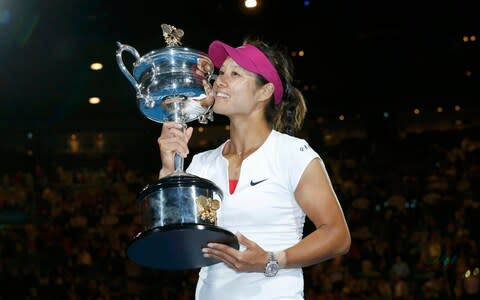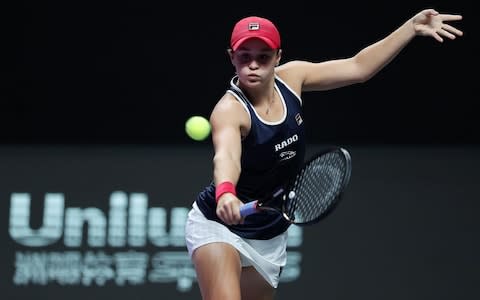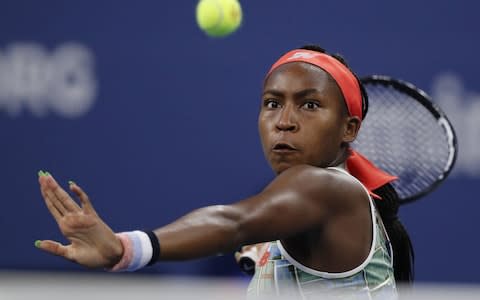The 2008 Olympics was a gamecharger for sport in Asia and it wouldn't surprise me if China becomes a tennis superpower in next decade

I’m in Shenzhen this week for the WTA Finals – an event which underlines the importance of the Olympic Games in spreading the gospel of sport.
When I started travelling to junior tournaments across the world, around 25 years ago, Asian players were conspicuous by their absence. But having the Olympics in Beijing in 2008 was a gamechanger.
That brought tennis into Asia in a big way, and when the Chinese do something, they really go for it. They have grown the game from the top-down, building some huge complexes, and now fund 25 WTA and ATP events. If the winner in Shenzhen this week wins all her round-robin matches, she could walk away with $4.75m (£3.7m). That would be the biggest single payday in the sport, even outstripping the grand slams.
When I think about what has happened with tennis in Asia, I’m amazed that some other sports – cricket, for example – have shown no interest in becoming part of the Olympics. That fortnight is the single biggest global showcase that any sport can have.
Over the last two years, I’ve spent quite a bit of time in China with the WTA’s Come Play programme. The idea is to develop a tennis workforce of schoolteachers and coaches.
Coach workshop @WTAFinals in Shenzen.
Creating games + exercises that do the teaching for me. Kids don’t want to listen to u - they want to play with u. So remove the technical instruction that they don’t understand. And invest in a good demo that they can copy. #MurrayMethod. https://t.co/aCjeu6zBWb— judy murray (@JudyMurray) October 26, 2019
The culture here is so different to what I am used to. The concept of public courts in parks doesn’t really exist. Nor do recreational clubs and competitions. The whole system of player development is based around identifying talent early and hothousing the most promising kids in academies. It seems to be working. You just have to look at the rankings to see that.
When I went to work with the WTA last year in Wuhan and Beijing, I discovered that the schools have 50 kids in each class. They marched onto the court and immediately stood in lines of ten, shoulder to shoulder. The discipline is as impressive as the concentration. I have an interpreter with me but the children are so good at repeating and copying that all I have to do is a short demo of each exercise or game.
The challenge with this approach is that it doesn’t leave room for much individuality and creativity. I hope that my coaching method – which focuses on fun skill-building activities – inspires the kids. I bring a variety of brightly coloured pieces of play equipment – from balloons to bean bags to water bombs – and they seem to take a lot of enjoyment out of things we think are relatively simple. I encourage them to think out of the box. Tennis is a very cerebral sport, after all.

Every sport needs its role models and the most famous Chinese player is Li Na, who won two majors starting with the 2011 French Open. She had a fun game to watch as well as a hugely engaging personality that people really warmed to.
Five years after her retirement, Li Na remains an outlier. But Qiang Wang has also climbed to a high of No 12 in the world this year, aged 27. She is a real poster girl with a big game and a striking look – I imagine she will be a big force in showcasing tennis out here.
It won’t surprise me one bit if China becomes a tennis superpower in the next decade or so. The culture of relentless repetition may have its drawbacks, but you can go a long way in tennis through hard work and a “Don’t miss” mentality. Look at the Koreans, and the incredible success they have had in women’s golf.
In Western cultures, we struggle with that disciplined mindset. In our world, there are so many distractions, so many other things to capture people’s attention and time. Perhaps life is just too easy nowadays.
Still, I have a really good feeling about the women’s game at this end-of-season finale. It’s great to see so many different game-styles, personalities, match-ups and back-stories. Last week I walked the Great Wall of China with Ashleigh Barty, who is one of my favourites. Whenever I have the opportunity to ask the WTA for a player to help with a coaching clinic, I always ask for Ash. She has great people skills and is so down-to-earth.

I’m also excited this week to watch the young Canadian, Bianca Andreescu, in person for the first time. Andreescu is only 19 but I love her firepower and gritty, never-say-die attitude. She is young and ballsy, has the ability to vary the pace and shape of her shots, and isn’t afraid of anybody. It’s very easy for young players to bow down in face of Serena Williams, for example, but she maintained her poise and self-belief so well in the US Open final to win her first major.
I like following Andreescu on Twitter too. As with 15-year-old Coco Gauff, who won her first title in Linz a fortnight ago, she is part of the social-media generation. If we want to have more personalities in our sport, we need ways to engage with them, and social media – for all its failings – offers that chance.

I was in Linz to see Gauff’s latest success. You often see sparse crowds in the early rounds of ATP and WTA Tour events but this was fabulous: full houses for singles and doubles. Coco almost singlehandedly sold the stadium out. She played doubles with Caty McNally, another big-hitting American team who loves to serve and volley, and I am sure a lot of young women were inspired. Not only does Gauff play great tennis but she interviews brilliantly – she is real and funny – and can only be a good-news story for the sport.
Whoever brought up the likes of Barty, Andreescu and Gauff gave them the full repertoire of shots and an ability to problem-solve both technically and tactically. They also ensured that they fell in love the win the game.
I hope some of the Chinese players of tomorrow will have the same variety and creativity. If they do, I will quietly celebrate the role of balloons, bean-bags and water bombs, as well as the overarching value of learning through play.

